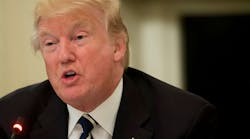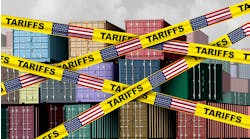Globalization, a seemingly unstoppable trend until last year, suddenly looks less inexorable as President Donald Trump moves to put "America First," and the United Kingdom leaves the European Union. These abrupt policy shifts are forcing executives to rethink strategies based on global economic integration, particularly cost-efficiency initiatives that rely on outsourcing or offshoring business processes.
Trump's first tariffs on Canadian lumber, proposed visa restrictions, and approach to foreign trade partners in general create new risks for companies that transfer work abroad or import foreign talent. At the same time, limits on global sourcing would add new urgency to a central objective of what we call a Fit for Growth approach--maximizing efficiency wherever possible in line with a capabilities-driven growth strategy.
Many companies that lose access to less-expensive overseas workers will respond by accelerating the automation and digitization of labor-intensive services. Possibly due to changes in the political and regulatory environments, companies may automate lights-on activities that don't support the differentiating capabilities underpinning their "way to play" in the marketplace.
No longer can U.S. companies and their overseas service providers rely on labor-cost arbitrage to drive efficiency. While we don't know how much of President Trump's agenda will become law, it is possible legislation could make offshoring harder, costlier, and even less popular with the public.
While we don't know how much of President Trump's agenda will become law, it is possible legislation could make offshoring harder, costlier, and even less popular with the public.
—Vinay Couto
Trump's public criticism of offshoring has focused mostly on the manufacturing sector, but there's no guarantee that trade barriers wouldn't expand to include some kind of levy on offshoring of services--one widely publicized transfer of a few thousand American IT jobs to an overseas locale might be all it takes.
The Trump administration’s review and potential reforms of the work visa system could include significant changes to service sector outsourcing. President Trump is also targeting changes to the H-1B visa program, which allows companies to bring in skilled foreign workers. U.S. technology companies along with Indian outsourcing providers rely on H-1B visas to resource large technology-centric outsourcing and process transformation projects. But President Trump has suspended expedited processing of H-1B applications, and could ultimately propose a higher minimum salary for H-1B visa holders. These measures would likely restrict access to overseas talent, drive up the cost of complex IT projects, and erode the cost advantages of bringing in foreign contractors. Longstanding relationships between U.S. companies and outsourcing service providers could face new regulations and restrictions, forcing both to rethink their sourcing strategies.
Three critical steps for companies planning to offshore or outsource work in the Trump era
Companies need new cost management strategies for an era of rising protectionism. Now is the time to develop those strategies. We recommend three steps to prepare for potential new limits on global sourcing:
1. Review your outsourcing contracts
Make sure your technology and business process outsourcing contracts provide you with flexibility. Look for provisions related to legislative changes, contract terminations, personnel migrations and clauses permitting you to move service delivery locations and terminate the engagement if it becomes uneconomical.
2. Evaluate Impacts of reshoring
Conduct a feasibility analysis of reshoring processes currently handled offshore. But avoid knee-jerk reshoring actions. Start by thoroughly evaluating the current economics of your offshore delivery model, then assess the financial and operational impact of various options for repatriating offshore operations. When choosing an onshore location, incorporate multiple factors and trade-offs in your business case. For example, Tier-2 locations offer moderate operating costs and broad, deep talent pools. Tier-3 and -4 locations suitable for low-cost transactional IT services may be poor choices if you need, or anticipate needing, more-advanced skills.
3. Leverage digital solutions.
Embrace smart automation technologies--robotic process automation (RPA), machine learning, cloud and cognitive computing--that now perform many business processes at the same or lower cost than low-wage foreign labor. For example:
- Up to 30% of finance and accounting, HR and procurement functions can be automated through digital technologies, generating savings that match offshoring, along with strategic benefits such as improved productivity and quality;
- Call centers that use cognitive agents and RPA to implement call deflection and call suppression capabilities can reduce headcount by 40-50%, outstripping the benefits of moving call center jobs to the Philippines, for example.
A long-term response to a looming threat
Trump's trade agenda and other threats to global sourcing arrangements require quick responses from outsourcing providers and their clients. However, the greatest impact may be in accelerating the evolution from labor-cost arbitrage to automated systems that drive far greater cost savings and efficiencies. Companies that keep pace with this long-term shift will move ahead of those that try to defend old business models.
Vinay Couto is a recognized thought leader with PwC’s Strategy& in the people and organization strategy practice. He is a principal with PwC US and a leader of PwC’s global Fit for Growth platform. He is the co-author of Fit for Growth: A Guide to Strategic Cost Cutting, Restructuring, and Renewal (Wiley, 2017).




